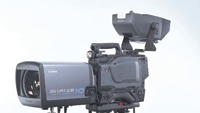Lens selection plays critical role in movie-style digital short

Achieving film-like results with 2/3in digital 24p HD camera systems requires cine-style prime and zoom lenses designed for motion-picture production methods. This is why independent co-producers and directors Noah Stanik and Skyler Stever chose Canon HD electronic cinematography prime and zoom lenses.
Stanik and Stever’s crew shot their latest project, “Tether Me,” in and around Portland, OR, in summer 2009. The filmmakers used two Canon HD electronic cinematography variable focal-length (zoom) lenses and a full set of six Canon HD electronic cinematography prime lenses to capture the look they were seeking. Canon’s cine lenses feature optical performance and traditional film-style attributes that make them familiar to experienced motion-picture cinematographers.
Stever, Stanik, digital image technician Mark Haleston and director of photography Kevin Ebel shot “Tether Me” in outdoor and indoor locations, including small rooms with actors positioned close to the camera. These were environments that would have been impossible to shoot in, the filmmakers noted, if not for the optical characteristics of Canon’s prime lenses.
The prime lenses feature a short minimum object distance (the minimum distance between the front of a lens and the object it’s focusing on) that facilitates high-quality close-up image capture. In addition, Canon’s Internal Focus technology employs a two-group floating optical system that minimizes optical aberrations.
Canon’s three cine-style HD electronic cinematography zoom lenses, including the HJ11x4.7B KLL-SC and the two used to shoot “Tether Me,” the HJ8x5.5B KLL-SC and HJ21x7.5B KLL-SC, and six FJ series HD electronic cinematography primes (ranging from 5mm to 55mm) are among the sharpest and fastest developed for the HD digital cinematography market.
The optical performance of these lenses is the product of Canon’s coordinated optimization of Modulation Transfer Function (MTF, a measure of image sharpness), image brightness and contrast across the 16:9 image plane. Other factors include a combination of high-index, ultra-low-dispersion glass, lens-element designs and multilayer coatings.
Get the TV Tech Newsletter
The professional video industry's #1 source for news, trends and product and tech information. Sign up below.
